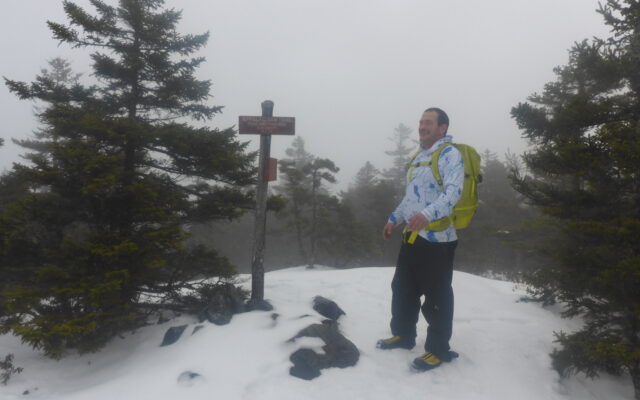
We didn’t intend to hike this mountain near Caratunk
By Ron Chase
Stormy weather ruined our plans for a western Maine mountain hike.
My son, Adam, and I had intended to climb lofty Number 5 Mountain in a remote wilderness area southwest of Jackman.
Several inches of new snow had fallen by the time we met in West Forks on a gray, foggy morning with a threat of light rain or snow showers. To reach Number 5 Trailhead required driving over slick dirt roads for about 20 miles, the last section likely unplowed.
Number 5 was written off.
We then decided to attempt Williams Mountain, another excellent peak positioned southeast of Jackman with better road access than Number 5. Most of the drive was on plowed, paved roads, but not all of it.

SUMMIT — A sign implanted in a cairn marks the summit of Pleasant Mountain near Caratunk.
We encountered problems when we arrived at the rough unpaved Williams Mountain Road. Although the road was previously plowed, additional snow had accumulated. An icy undercoat made it unsafe to navigate.
A search for another mountain hike ensued.
After studying our Maine Atlas while parked at the snow-filled entrance to Williams Mountain Road, we decided to climb Pleasant Mountain. Our choice was the “other” Pleasant Mountain situated east of the village of Caratunk as opposed to the very popular Pleasant Mountain hike in the southwestern part of the state.
Located about 10 miles south of West Forks, hiking access to Pleasant Mountain is via the Appalachian Trail. From Route 201, we drove through Caratunk on Pleasant Pond and North Shore Roads to an intersection a short distance from the AT.
The last portion of North Shore Road was icy but manageable.
We hiked down the ice- and snow-covered access road to a sign for the AT.
Initially, the trail travels through wet, low-lying terrain. The recent storm left the surface partially covered by ice and snow, and very muddy.
Although discouraged, we persevered through the water-saturated landscape and past side trails to Pleasant Pond and a lean-to.
Our spirits improved when we gained higher and drier ground and progressed steeply upward on a carpet of snow and ice in a sparse conifer forest.
Several weaving precipitous sections required careful maneuvering and walls of ice on two steep inclines had to be skirted by bushwhacking.
After advancing to the upper reaches of the mountain, the gradient moderated as the trail circled around the north side of the peak.
Many years have transpired since either of us has climbed Pleasant Mountain. Neither of us recalled this essentially flat circuitous sector of trail, and speculated the path has been rerouted in the interim.
The lengthy, almost level, segment of pathway allowed for virtually effortless hiking. Shortly after, the trail angled southeast and we began ascending steadily in stunted conifer growth.
A massive snow-capped boulder marked a dramatic change in the character of the trail and required careful maneuvering on an icy surface along the less vertical right side. We then scrambled up a steep sloping ledge that appeared to be the mountaintop.
The rounded barren prominence turned out to be a false summit. Exposed ledges continued east. We hiked easily in a few inches of wet snow through a sparsely wooded area and climbed another bald peak to the true summit marked by a sign implanted in a cairn.
Thickening fog concealed what would have been spectacular views.
Swirling clouds and fog-enveloped alpine environments have their own special appeal. We embraced the moment and put on our parkas. We paused to enjoy a late lunch and took a much-needed break.
We had completed the climb without using microspikes, but descending on snow and ice was much more hazardous so we opted to wear them on our return.
It was a good decision because they permitted traveling down the often slippery trail with confidence and minimal difficulty.
We took off the spikes when we arrived at the low-elevation wetlands.
The remainder of our trek was relegated to trudging through a messy mixture of mud, snow and soft ice.
But given the inauspicious beginning to the day, we were consoled by the realization that what began as a lemon had turned into lemonade.
My book, “Maine Al Fresco: The Fifty Finest Outdoor Adventures in Maine” narrates nine more mountain hikes around the state, including several winter expeditions.